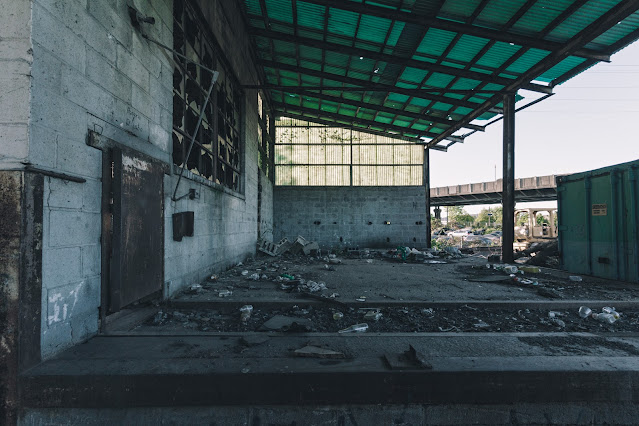Former Empire State Chair Factory
Between the Hudson River and the 832-foot High Tor mountain, Haverstraw sits at a unique crossroads of natural beauty and historical significance. To the east lies the Hudson River, while to the west, High Tor State Park—part of the Palisades Interstate Park System—provides a scenic backdrop. To the north, the town stretches to Bowline Park, and to the south, it borders the Tilcon Quarry. The twin smokestacks of the Bowline Point power station stand in the distance, marking the town's industrial roots.
During the American Revolution, Haverstraw played a key role. Soldiers used the high vantage point of High Tor as a lookout, lighting beacon fires to warn of approaching British ships on the Hudson River. Fast forward to the early 1900s, and the town was known as the "brickmaking capital of the world." With 42 factories producing 148 different brands of bricks, Haverstraw had everything needed for the trade—rich clay deposits along the riverbanks, fertile soil, and plenty of straw. The town’s location on the river made transporting bricks easy, with much of New York City’s skyline being built from Haverstraw's bricks. After the brick industry collapsed, other waterfront industries took its place, keeping the town's economy afloat.
Haverstraw's origins date back to 1666, when Dutch settlers founded the town. However, the village historian notes that the name "Haverstroo" appeared on Dutch maps as early as 1616. The village was officially incorporated in 1854 and still maintains its own fire, police, and ambulance services. In addition to the village of Haverstraw, the town is home to two other incorporated villages—West Haverstraw and Pomona—as well as three unincorporated areas: Thiels, Garnerville, and Mount Ivy. Haverstraw’s rich history, stunning landscape, and strong sense of community make it a unique and vibrant place to live.
The next five to ten years will be a critical period for Haverstraw as Westchester developer Martin Ginsburg moves forward with his plan to revitalize the village’s waterfront. His vision includes building 850 housing units, but the success of this project hinges on several factors, including how he handles the Empire State Chair Factory site. This location has become a focal point in the community, with many watching closely to see how Ginsburg navigates the property’s complicated history and its current owners.
The Empire State Chair Factory was once a cornerstone of Haverstraw’s economy, but the site remained unused since 1995 and was demolished sometime in the 2010s. The families of the former owners, including Bruce Kanner, still pay taxes on the property. However, their efforts to develop it have been stalled, largely due to opposition from village officials and the site’s placement in a condemnation zone. This has left the families feeling frustrated and uncertain. Kanner has said that meaningful negotiations with Ginsburg have yet to occur, despite claims from village Trustee Angelo Cintron, who believes otherwise.
The factory’s legacy looms large in the minds of Haverstraw residents like Bolivar Marchand and Hector Torres, who remember its role in the village’s economy. As the redevelopment plan moves forward, the community is paying close attention. There are hopes that the project will honor the site’s history while providing real benefits to the village. At the same time, residents are concerned about potential gentrification and the displacement of local businesses and long-time residents. Ginsburg’s approach to the Empire State Chair Factory site, particularly in how he engages with the families who own it, will be a key test of his commitment to the village’s future.
This development will not only shape the landscape of Haverstraw but also the community’s trust in Ginsburg’s promises. His actions in the coming years will reveal whether his plan truly serves the people of Haverstraw or prioritizes profit over the village’s welfare.
As of today, Pennrose and MPACT Collective have been chosen by the Village of Haverstraw as the preferred developers for the site. The plan aims to transform the area into a vibrant neighborhood with 450 mixed-income housing units. These homes will cater to a range of incomes, ensuring that affordability remains a key part of the development.
In addition to housing, the project will feature a community center, a fitness center, open green spaces, and on-site parking. There will also be connections to the Hudson River, making it easier for residents to access the waterfront and enjoy its scenic beauty.
This development represents a significant step forward for Haverstraw, as it blends affordable housing with community-focused amenities. The project's vision is not only to create new living spaces but also to strengthen the village's sense of community while honoring the site's historical significance. Residents are hopeful that this initiative will bring lasting benefits to the area without displacing long-time locals or businesses.
Sources:
1. Baird, B. (2003, August 14). With development, Haverstraw must wait and see. The Journal News.
2. Aiges, S. (1985, June 16). If You're Thinking of Living in Haverstraw. NYTimes.
3. (n.a). (2021, July 21). Village of Haverstraw Releases RFP To Develop Waterfront Parcels. Real Estate in Depth.
4. Katz, P. (2022, December 24). Haverstraw projects set for $10M state grant. Westfair Business Journal.
5. Matsuda, A. (2018, February 16). Haverstraw unveils development concept for chair factory site. lohud.
6. Records & Briefs New York State Appellate Division. (n.d.). (n.p.): (page. 5-6).
7.







Comments
Post a Comment